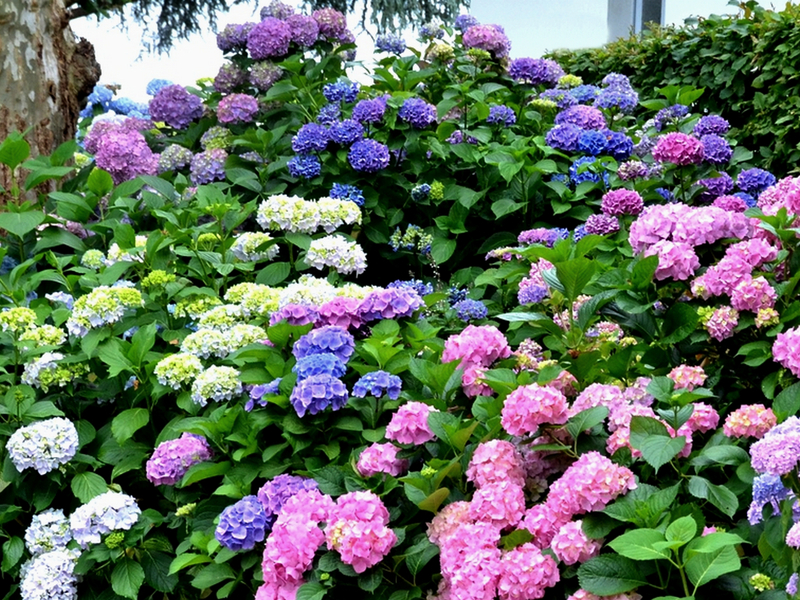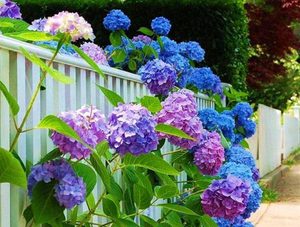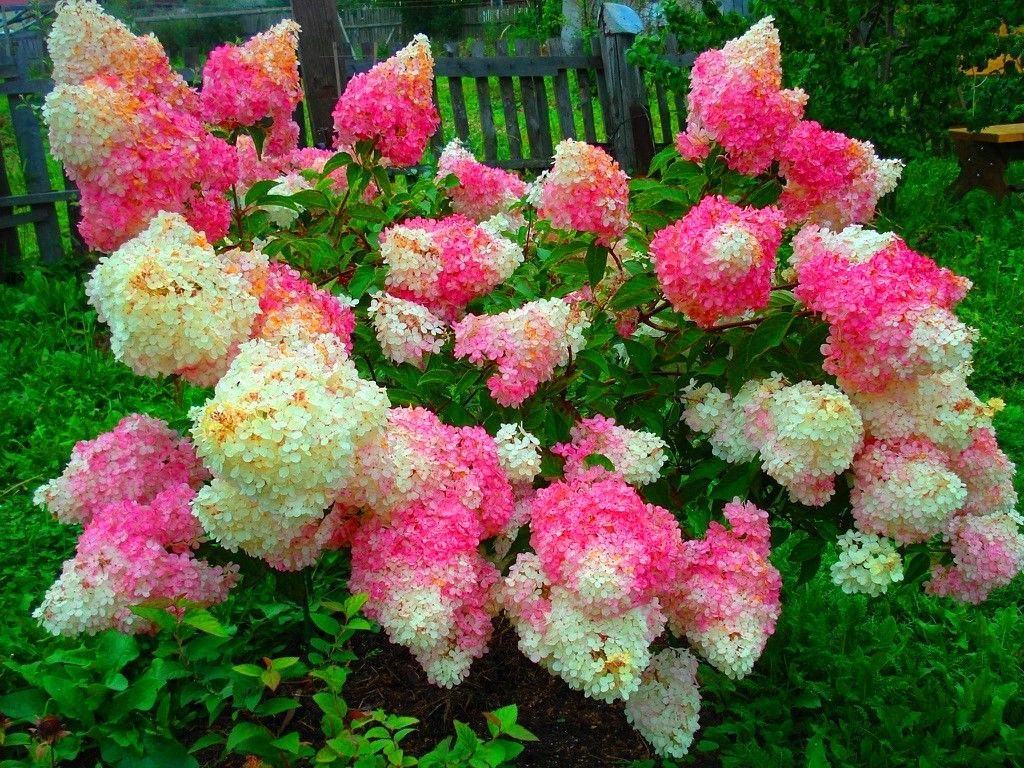Having set out to decorate their site, many gardeners often use hydrangea shrubs for such purposes. With them, any backyard area will be able to acquire a particularly spectacular look. Among the numerous varieties of the plant, of particular interest is the panicle hydrangea grandiflora, which is very popular among domestic flower growers.
Its decorative character is given by large pyramidal flowers. Also this type of hydrangea it is in demand due to frost resistance, therefore, during preparation for winter, you can not use special shelters.
Content
Description and features of the variety Grandiflora
This hydrangea variety can be grown in two main forms - as a bush or as a medium-sized tree. Usually an adult hydrangea grows 2-3 meters high, the crown has the same dimensions. Unlike other species, hydrangea grandiflora leaves appear late in spring. In comparison with its relatives, this variety forms rather large flowers in spring. They have a characteristic pyramidal shape and can grow up to 30 cm in length.
The flowering phase is long and lasts from July to September. A serious disadvantage of the plant is the sterility of the flowers, therefore, fruits for reproduction cannot be obtained from them. At the moment when the first flowers begin to open at the hydrangea of the treelike grandiflora, the latter have a soft cream shade, but over time it changes to bright white, and at the end of the phase the flowers turn pink.
The hydrangea treelike grandiflora gained great popularity due to its following advantages:
- lush bloom with large flowers;
- frost resistance;
- high growth rate;
- durability (grows up to 40 years);
- resistance to diseases and pests.
Planting and caring for grandiflora hydrangea
Growing this hydrangea variety requires the creation of favorable conditions for it, without which it is difficult to count on abundant and colorful flowering during the summer season.
Choosing a landing site
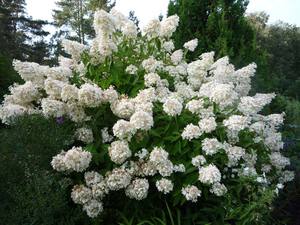 A prerequisite for the normal development of the panicle hydrangea grandiflora is the presence of sufficient light, therefore it must be planted in those places where it will be provided constant diffuse lighting.
A prerequisite for the normal development of the panicle hydrangea grandiflora is the presence of sufficient light, therefore it must be planted in those places where it will be provided constant diffuse lighting.
In the absence of other suitable places, the flower can be grown in partial shade. However, when planting in an open space, it is necessary to create an artificial shade, since when the direct rays of the sun hit, the hydrangea begins to grow slowly, to which its flowers react by decreasing in size, and in some cases it is not possible to wait for flowering at all. Also, the place chosen for the hydrangea grandiflora should be protected from the wind.
The most suitable place for growing panicle hydrangea grandiflora is a place next to a wall or fence, where it will be provided with shade in the heat, and on windy days - reliable protection against drafts.
Air quality does not in any way affect the development of the Grandiflora hydrangea, so it can be grown as a hedge in an urban area along a motorway.
Priming
The hydrangea grandiflora feels best in areas with an acidity not higher than ph 6.5. In soil with a neutral reaction, it grows much worse; it is least desirable to grow it in alkaline soil, where the risk of its death is high. In the absence of suitable places, panicle hydrangea can be planted in clay soil. During fertilizing, it is not recommended to apply fertilizers such as lime, wood ash and chalk there. To increase soil fertility, it is recommended use the following composition:
- sod land (2 parts);
- peat (2 parts);
- sand (1 part);
- humus (part 1).
It is also useful to add pine needles to it. Maintaining fertility in the area where the hydrangea grandiflora is grown is a must, since it requires a large amount of nutrients during the flowering phase.
Watering
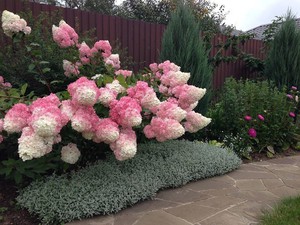 This plant responds positively to moisture, which it demonstrates to the greatest extent during the flowering period. At this stage of development, it is necessary to water at least once a week in an amount 1.5-2 buckets for one plant... Treelike hydrangea grandiflora can easily tolerate long breaks between waterings. Due to its drought tolerance, it will withstand such extreme conditions, but this will lead to a decrease in the number and quality of inflorescences. When determining the frequency of watering, it is necessary to be guided by the current weather, since during the rainy period the number of waterings can be reduced.
This plant responds positively to moisture, which it demonstrates to the greatest extent during the flowering period. At this stage of development, it is necessary to water at least once a week in an amount 1.5-2 buckets for one plant... Treelike hydrangea grandiflora can easily tolerate long breaks between waterings. Due to its drought tolerance, it will withstand such extreme conditions, but this will lead to a decrease in the number and quality of inflorescences. When determining the frequency of watering, it is necessary to be guided by the current weather, since during the rainy period the number of waterings can be reduced.
Top dressing
Best of all, hydrangea treelike paniculata grandiflora grows on well-fertilized soils. During the flowering period, it must be provided with minerals, therefore, additional feeding should be carried out at this stage of development.
The greatest effect is achieved if fertilizers are applied in stages:
- for the first time, feeding is carried out in the spring using organic fertilizers, mainly fermented manure. But here it is important to correctly calculate its amount, because otherwise the flowers will grow unusually large and break the stems due to their large weight;
- during the period of bud formation, the soil is fertilized with a mixture based on superphosphate and potassium sulfate (35 g each) and urea (25 g) for each sq. m. soil;
- an effective measure that increases the duration of hydrangea flowering is the introduction of mineral fertilizers into the soil in accordance with the scheme - 25-30 gr. for every 10 liters of water.
Breeding methods for panicle hydrangea
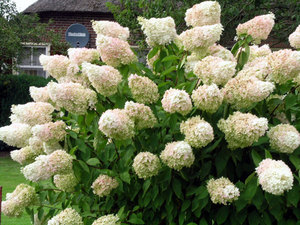 The main methods of breeding hydrangea grandiflora are the use of cuttings, branches and division of the bush.
The main methods of breeding hydrangea grandiflora are the use of cuttings, branches and division of the bush.
Cuttings are harvested in early July, choosing as planting material tops of branches... If the shoots are cut off at other times of the year, their survival rate decreases. Each stalk should have 5-6 leaves. The two lower ones can be immediately removed, and then the stalk must be placed in loose earth, deepened by two nodes, and set a jar on top as a shelter. The cutting root is best when grown in the shade and kept moist.
The hydrangea is propagated by dividing the bush in the spring until the plant begins to bloom. You can also do this in the fall, after waiting for the plant to wither. First, you need to dig the flower out of the ground and carefully divide it into 2-3 parts. As a result, the resulting fragments must have 2-3 buds recovery. Then the prepared parts are transplanted into the holes, the bottom of which should be pre-filled with a mixture of organic and mineral fertilizers.
Hydrangea can also be bred with layering, although it takes longer. First you need to select one branch, remove the leaves from the end, and then part of the bark.At this point, it is bent to the ground and buried so that it is ruined by 15 cm.
It is recommended to use wire to securely fix the branch in this position. Branch care is reduced to regular watering until a well-developed root system is formed. Further, the branch can be separated from the mother plant and transplanted to the prepared place.
Pruning
Pruning hydrangeas is not only a must but also a recommended operation. The fact is that it starts the process of forming new branches and inflorescences. In order to accelerate the growth of the bush, it is recommended to remove branches for a short length - no more than 2-3 kidneys... If it becomes necessary to ensure the lush flowering of hydrangeas in the spring, it makes sense to cut off all the old shoots at the root.
Caring for hydrangea in the fall requires pruning of faded inflorescences. The fact is that they consume essential nutrients, which is why flowering ends earlier.
Diseases and pests
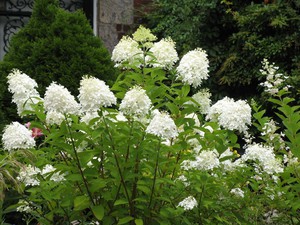 A great danger to the hydrangea grandiflora is represented by such diseases known to every gardener as powdery mildew and garden aphids.
A great danger to the hydrangea grandiflora is represented by such diseases known to every gardener as powdery mildew and garden aphids.
High efficiency for a long time in the fight against powdery mildew was shown by such drugs as Ochikom, Fundazol. With regular treatment with them before flowering, hydrangea can protect against disease... However, these insecticides must be applied strictly in accordance with the instructions.
You can get rid of aphids using chemicals or self-prepared folk remedies: a solution of infused garlic (250 g), mixed with laundry soap (50 g), has proven itself well.
Conclusion
Hydrangea paniculata grandiflora is one of the interesting varieties of its family. She fully adopted all the main signs of hydrangea, therefore she feels great on various types of soil and tolerates spring frosts well. This plant will not give much trouble in care. However, it is necessary here follow certain rules.
Despite the fact that the panicle hydrangea grandiflora is a light-loving plant, it is recommended to grow it in partial shade, because with abundant light, the flowers begin to shrink, which is why it loses its decorative properties. Watering is no less important for her: although hydrangea can go without water for a long time, it is not recommended to allow such pauses, otherwise the flowers will lose their characteristic saturated shade.
